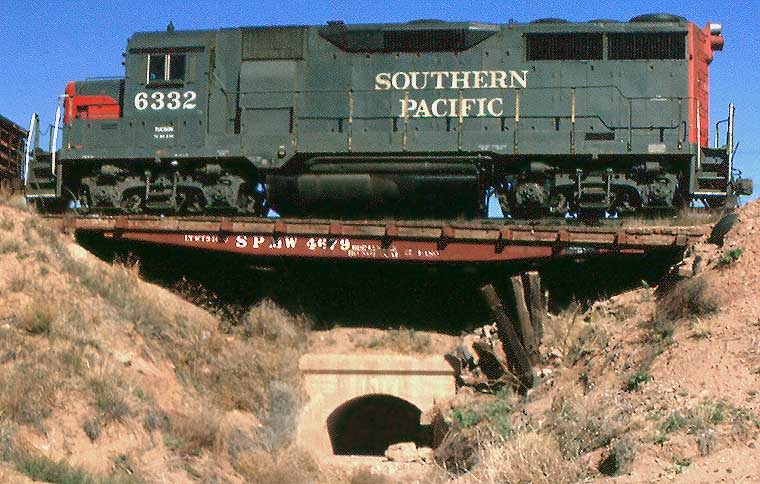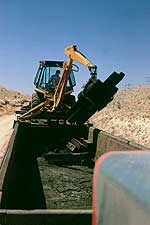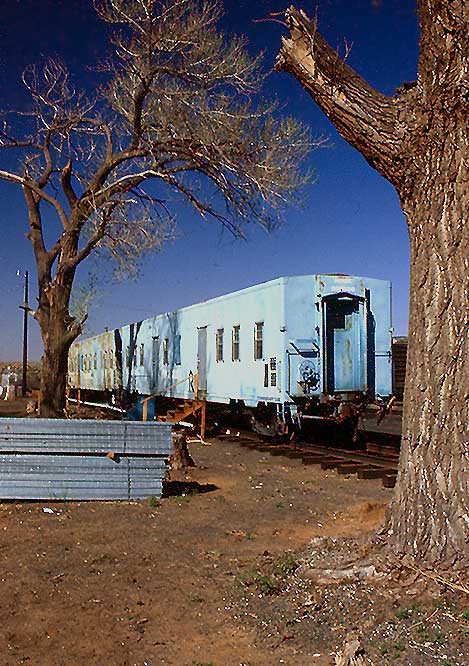
Contractor's ex Rock Island (former troop sleepers) crew cars, looking timetable west at Santa Rosa; an ex Illinois Central heavyweight was coupled at the far end (behind the tree). In 1984, the Club cafe was a popular Santa Rosa hangout dating from the Route 66's heyday. It's gone now, except for the sign.
At the time, Southern Pacific was in the middle of rebuilding the Golden State Route between Kansas City and El Paso, so that it could again compete with Santa Fe in the Midwest-to-California trade. In the years preceding the dissolution of the Rock Island, the line gradually faded away as through-freight corridor to the point where it typically only hosted one train each way per day.
Accordingly, both the SP and ex Rock Island portions of the line were in pretty bad shape. Many of the ties dated to the SP's takeover of the El Paso & Southwestern in the mid-1920's (as evidence, I still have the date nails that I pulled). Rail generally was jointed 112-113 lb. and pounded to death. When the gangs came through to replace the ties prior to laying ribbon rail, the old rail often broke in the process.
Two gangs called Santa Rosa home at the time of these photos. The work train's "tie-dumping gang", consisted of SP foreman Bill Frye, a young kid who operated a tractor, and the train crew - engineer, conductor and two brakemen (historical footnote: a few weeks later, SP instituted the attrition process that would eventually eliminate the second brakeman from trains).
The other outfit was a private contractor's "production gang", which performed the actual track overhaul. Many of these guys were Navaho Indians, and, boy, could they work! After hours...boy, could they drink! I spent considerable time with them in a bar near the tracks, and they certainly were an enjoyable bunch.
Tie dumping was slow and dull - done at walking speed. On the first day, the engineer soon became bored, and after showing we two brakemen the rudiments of locomotive operation, removed himself to the caboose to yak with the conductor. This was my introduction to running a locomotive.
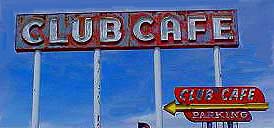
Other relics were still around as well. One of SP's ubiquitous concrete phone booths, also retired, stood behind the depot (click on the photo for more on them). What I'm assuming was a pump house (because of the inward-sloping walls) sat a stone's throw from the Club Cafe (barely visible at the left of the photo)
.
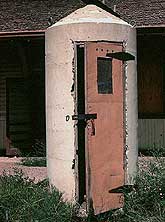
An old heavyweight passenger car of uncertain provenance sat across the tracks from the depot.
The only inhabitated structure was the portable train order office (see top of Train Order War Stories), and that, too, closed after DTC rendered the train order operators surplus at mid year.
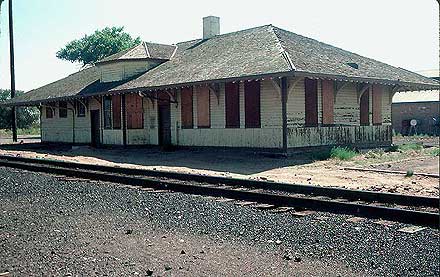
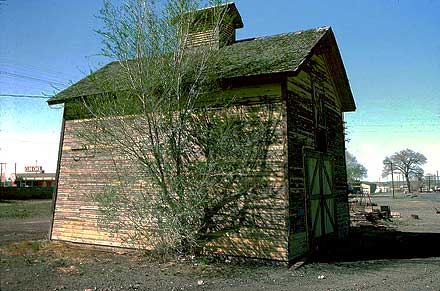
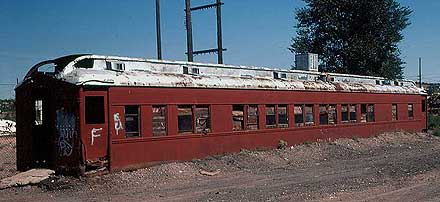
Of note is Cotton Belt's four-year-old GE B30-7 number 7788, sporting one of SP's many elephant ears permutations (in this case, sound baffles, not cold air intakes). The B-Boats' air filters were prone to clogging in the Southwest's dusty, sandy conditions. This, combined with SP's gas-'em-then-run-'em-'till-they-break maintenancee, provided a nightly show of oxygen-starved units blasting fire six feet out of their stacks. Nevertheless, the 7788 survived well into UP era (sans ears), finally being withdrawn for "rebuilding" as an RP20BD, UPY 2667, in 2007.
Behind Tunnel Motor 8340's ample nose, we can barely see the rear snoot of GP35R number 6332, the locomotive that propelled the tie-dumping gang's train, sitting on the Stock Track. On any normal day, soon as the traffic clears, it and my crew would occupy the main for some perfunctory switching, then head east to a point just beyond the Santa Rosa siding to begin dumping ties. But on this particular day, things went to hell in a handbasket, for it was the day of The Big Jackpot.
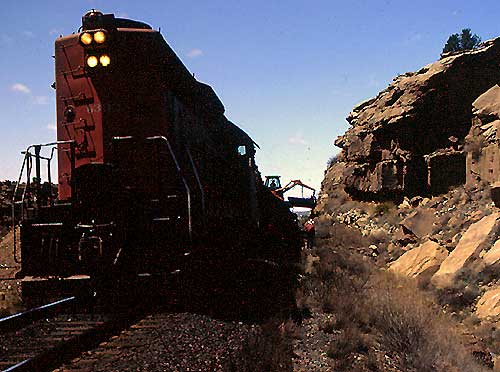
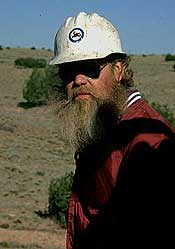
The 'heart' of the operation was this machine with the custom outriggers. The operator dragged himself from car-to-car using the claw. To get the tractor from the ground onto a new trainload of ties, he operator positioned the tractor in-between two cars and placed the end loader on top of one gondola end, and the claw on the end of the other car. Then he slowly raised the tractor to a level above the car ends, so that the train crew could gingerly couple the cars while the tractor remained suspended in space. Nuts, if you ask me...
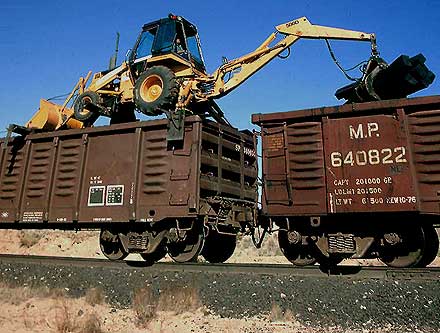
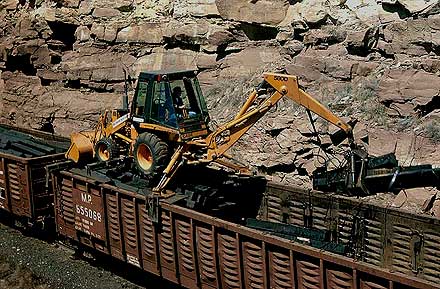
The ties that you see here had to be carefully placed upon the ground, because Bill Frye and the operator found that dropping them caused many to snap like matchsticks. The ties were yellow pine, not hardwood, and were dipped, not pressure-treated. Four spikes per rail (normal: two) had to be used on each tie on straight track to keep the rails in gauge. On curves, a fifth 'hold-down' spike (through the hole in the tieplate's outer part) was added, and this was barely adequate.
SP ballasted the first sections of revamped track with limestone ballast from a quarry on the Santa Fe, and a Vaughn Turn out of Tucumcari fetched a trainload of ballast cars from the Santa Fe interchange every day or two. As it turned out, the limestone pulverized under the weight of trains, and quickly lost its holding ability.
SP turned to copper slag ballast from Arizona, and it held like glue. Unfortunately, it's also a great conductor, so for awhile, every time it rained, all of the signals would go red. Eventually, the signal maintainers were able to adjust the signal circuits' sensitivity to (mostly) eliminate the problem.
The Vaughn Turns still continued to run, though. SP continued using its limestone to shore-up the Cotton Rock above Tucumcari, leading me to conclude that the engines and cars must have been easier on the ballast up there due to gravitational fluctuations.
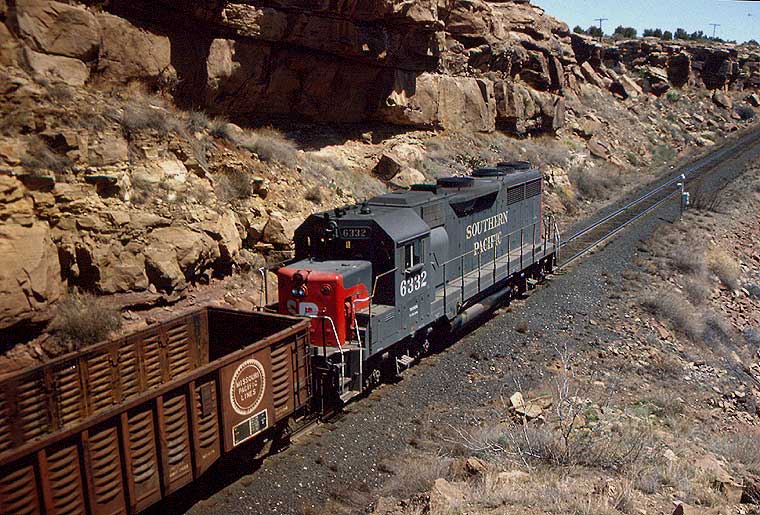
These worktrain photos were all recorded in and about a rock cut just to the timetable east of Santa Rosa siding. You'd think that there would be lots of rattlers in those rock, but I saw nary a snake during my entire Tucumcari tenure. At the time, a sizeable number of the train and engine crews packed sixguns in their grips, the most common rationale being that they were packing "in case of rattlesnakes". Even some engineers made this assertion. Yep, boys, you bet! See How to Call the Dispatcher for more on rattlesnakes.
Below: No, the old flatcar is not supporting the engine. It's a bridge on the parallel service road. For more info on this car, see: Southern Pacific SPMW 4679 Flatcar.
